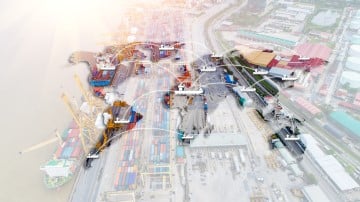Supply Chain Network Strategy & Optimisation
Supply Chain Consultancy » Supply Chain Network Strategy
What Is the Goal of Supply Chain Network Design
The goal of a supply chain network design is to create an efficient and reliable flow of materials from supplier to customer by leveraging and aligning logistics infrastructure, freight routes, systems, and inventory management policies. In a growing number of cases, due to the implementation of circular supply chains, this extends from the customer and back to the warehouse and back up the supply chain.
A supply chain extends from the extraction of raw materials all the way to the customer and through to recycling and refurbishment. Whilst responsive, resilient and efficient supply chains are the goal for all, supply chain managers need to balance the trade off between these goals. Once the supply chain strategy has been defined, the various components of the supply chain need to be aligned to ensure that the strategy can be successfully executed.
This includes selecting the right suppliers, using the appropriate modes of freight, holding suitable inventory levels, sensibly locating factories and warehouse facilities, and deploying technology solutions and policies to enable smooth movement of goods. Different businesses prioritise different types of supply chains. For example, aerospace and defence focus on quality and reliability while fashion prioritises speed to market. The automotive sector requires responsiveness, but spare parts supply chains focus on stock availability.
How BoxLogic Can Help
BoxLogic can design, optimise or evaluate the impact of particular actions on supply chain networks in a variety of ways, depending on the actual requirements of each business. Common scenarios our team of supply chain consultants deal with include:
Project Stage | How Can BoxLogic Help |
|---|---|
Supply Chain Network Design and Optimisation | A study to identify the most appropriate configuration for a distribution operation. Whether a business is looking to create a strategic roadmap for how to develop its supply chain network over time or are coming to the end of a lease on key infrastructure, this looks holistically at a range of the relevant cost and service implications. |
Capacity Development | Determine the strategic roadmap for how a supply chain network should develop over time with growth. This considers where additional sites should be added or where existing sites should be moved to as leases expire to create cost efficiency or network coverage of a country or region. |
Locational Analysis | Analysis of inbound and outbound volumes to establish the centre of gravity (or centre of gravities) of a distribution network. Centre of gravity analysis can be a useful tool in identifying the potential location(s) of manufacturing and warehouse facilities. |
Infrastructure Review | A review of supply chain infrastructure to assess its suitability for an operation in terms of its size, location and functionality. Reviews can be carried out on either existing or potential supply chain facilities. |
Service Level Optimisation | Evaluation of a range of warehouse and transport options to improve the service to customers within a distribution network. This will involve identifying the changes required to achieve alternative service levels. |
Supply Scenario Assessment | Assessment of the cost and service impacts of relocating supply of goods from one location to another. This may be as part of a low-cost sourcing exercise to reduce the cost of supply or a ‘near-shoring’ strategy to improve supply chain agility and resilience. |
Outsourcing and Insourcing Evaluation | Evaluate the costs and benefits of using outsourced solutions as part of the supply chain network configuration in addition to assessing the requirements of taking operations back inhouse. |
Our Process
Strategic distribution network design projects are a core capability for BoxLogic and we use our tried-and-tested approach to deliver a recommended network configuration for our clients. All projects have different requirements, but a typical project approach is outlined below:
We develop a strong working understanding of your supply chain network and operating model by facilitating a kick-off workshop and interviewing key stakeholders to enhance our understanding of the project requirements.
We analyse representative data sets to understand current operational flows and produce visualisations of the current network to illustrate how it works and where the opportunities lie. We perform centre of gravity analysis to identify potential warehousing or manufacturing locations. Operational flows are overlaid with growth projections to create a ‘planning base’. This is used as a key input to the option modelling phase.
Our consultants agree a shortlist of feasible options with the client project team. We then create bespoke models to evaluate the financial and service level implications of each scenario. Sensitivity analysis is produced to test each option under a range of scenarios to ascertain its robustness. A preferred solution is then agreed for further development.
We work with you to further develop the preferred solution into an end-to-end solution with a road map for transitioning to the future state network. We also support the building of a business case for board approval.
Case Study
Find out how we helped our client to assess the benefits of relocating manufacturing and distribution to Eastern Europe.
Challenge
A designer and manufacturer of high-end electrical kitchen equipment wanted to assess the potential benefits of relocating the manufacturing and distribution of the business to a lower cost location in Eastern Europe from the UK.
Project Approach
- Analysed the existing business flows, taking into account future changes to understand volumes and the current cost base of the UK operation
- Estimated the costs of production of operating in different locations across Europe, to understand the potential financial impact of any relocation of operations
- Assessed the non-financial aspects of each country to understand how easy it is to setup businesses, find available labour with manufacturing expertise, how integrated each location is to wider global supply chains and the levels of local governmental support
- Compiled our findings in a report that was shared with the clients management team to support their internal decision making
Results
BoxLogic provided the client with a report that clearly articulated the benefits and potential risks of relocating it’s manufacturing and distribution operations to Eastern Europe, allowing them to take the required strategic decisions to move forward as a business.
Why Work With BoxLogic
Our team of dedicated supply chain professionals are well placed to help you on your next supply chain design or optimisation project for several reasons.
- All BoxLogic recommendations are underpinned with rigorous analysis and modelling to give confidence in our work
- Expert consultant team with the right blend of strategic and operational experience so that we can be pragmatic and innovative in our recommendations
- We use bespoke modelling tools rather than ‘black box’ software so that we can fully explain and interrogate our output
- Excellent background of delivering similar projects for businesses of all sizes across a wide range of industries
- Capability to support the end-to-end project from network configuration design to implementation of the preferred solution
GET IN TOUCH TODAY
Complete the form and one of our skilled consulting team will be in touch to discuss your warehouse and logistics project today.
Alternatively, give us a call or send an email.
- +44 (0) 118 309 4030
- enquiries@box-logic.co.uk
Frequently Asked Questions
A supply chain network design is dependent on the alignment of many integrated factors within your supply chain including physical, systemic, and stock. Physical considerations such as the positioning of your customer base, suppliers and your own operations are to be assessed in conjunction with available transport routes. Systemic considerations focus on how demand and supply signals are accurate and reliably transmitted throughout the supply chain. Stocking policies consider how and where inventory will be located across the supply chain to ensure good availability to customers within agreed cost parameters.
Supply chain network design is the operating model for how a business brings goods to its customers. It involves the location of manufacturing plants or suppliers, the locations of warehouses, the breadth and depth of stock held at each warehouse, the transport routes and modes used, and the systems used to provide visibility and respond to demand across the supply chain. A fine balance is always in play between cost efficiency, speed of fulfilment, availability of stock to customers, carbon emissions as well as other sustainability considerations.
Businesses must respond to internal and external factors to manage the supply chains, operating from stable countries with safe reputations to protect their own reputations and ensure a smooth supply of goods. Adjusting one element can have significant impacts on the rest of the network, for example, offshoring production extends lead times and necessitates increased stock levels in customer markets to protect against supply failures, which requires larger warehouses. Similarly, a more focused breadth of stock in warehouses might create space and reduce working capital but it could dramatically increase freight costs of non-core items.
Supply chain managers must design a solution that balances each of these requirements whilst continually adapting to outside forces, as has been too evident as we have come out of the pandemic.
Incoterms are a set of 11 different rules defined by the International Chamber of Commerce (ICC) which dictate the responsibilities of sellers and buyers with the international movement of goods. They detail the task, costs, risks, and liabilities to be borne by each party.
The seven Incoterms rules for any mode(s) of transport are:
- EXW – Ex Works (place of delivery)
- FCA – Free Carrier (named place of delivery)
- CPT – Carriage Paid to (place of destination)
- FOB – Freight on Board (port of loading)
- CIP – Carriage and Insurance Paid To (place of destination)
- DPU – Delivered at Place Unloaded (place of destination)
- DAP – Delivered at Place (named place of destination)
- DDP – Delivered Duty Paid (place of destination)
Organisations that want to take more control of their inbound freight typically work with incoterms from EXW to FOB while other businesses that want to take less control of the freight and risk prefer CIP to DDP.
With the ever-apparent effects of global warming, an over dependence on finite fossil fuels, and a rise in shipping costs, world governments have recognised a need to move away from wasteful linear economies and adopt sustainable circular economies. The same can be said for circular supply chains looking to be environmentally conscious. This is achieved through making supply chains shorter and more local, so goods have shorter distances to travel, and ensuring both renewable materials such as water and food waste and technical materials like plastics and metals are recycled throughout the supply chain.
Good examples of circular supply chains are rental models of fashion where consumers rent clothes for a limited period before returning to the supplier to be cleaned and refurbished so that it can be used by the next person. Right to repair legislation of electronics seeks to prevent built in obsolescence to lengthen the lifespan of products and allow for them to be repaired when things do go wrong.





